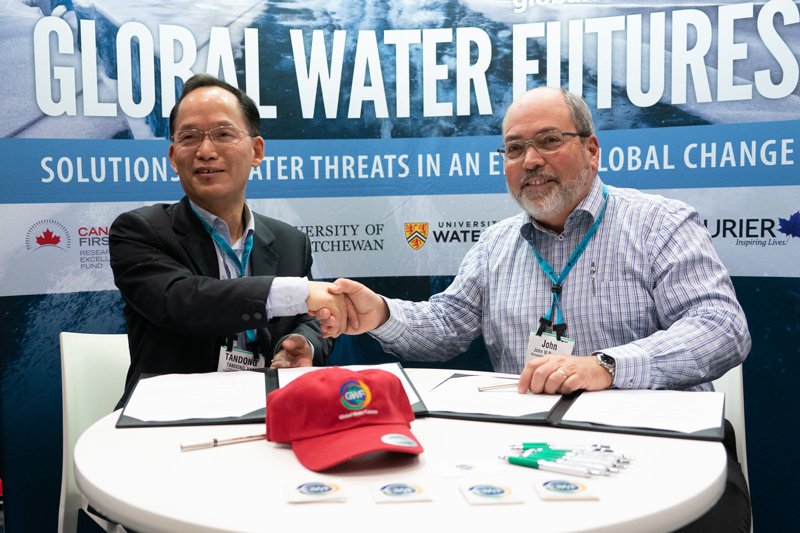
Top Canadian and Chinese water research programs sign MOU
Global Water Futures and Chinese Academy of Sciences hopes partnership will strengthen management of the world’s freshwater resources
By Mark FergusonWASHINGTON DC – During the annual meeting of the American Geophysical Union (Dec. 14), delegates from the University of Saskatchewan (USask) and the Chinese Academy of Sciences (CAS) signed a five-year Memorandum of Understanding (MOU) that will strengthen both Canada and China’s commitment to managing freshwater resources globally in a time of rapid climate change. The partnership involves the USask-led Global Water Futures (GWF) – the world’s largest university-led freshwater research program – and Institute of Tibetan Plateau Research, Chinese Academy of Sciences (ITPCAS) and the Third Pole Environment (TPE) program.
The MOU is a direct outcome of discussions between GWF and TPE at the Open Science Conference of the World Climate Research Programme’s Global Energy and Water Exchanges Project in Canmore, Alberta in May where the need and opportunity for greater global collaboration was identified. Through initiatives such as collaborative research projects, personnel exchanges, and exchanges of scientific information and technical data, the goal is to advance water and climate research in critically important areas – especially the high mountains of Canada, the Arctic and the Tibetan Plateau, which is also known as the Third Pole – including climate change impacts on ecosystems, river basins, water bodies and natural resources development.
“The mountains of Canada and China are experiencing climate change, deglaciation, loss of snowpacks and thaw of permafrost at an alarming rate and it is critically important that we better understand the impact of these changes on downstream water resources” said Dr. John Pomeroy (PhD), GWF director and USask Canada Research Chair in Water Resources and Climate Change. “Mountains are the water towers of the world and by working with TPE to better predict changes in major rivers such as the Saskatchewan, Yangtze, Yellow, Indus, Mackenzie and Columbia that drain mountain headwaters to provide water supply for over half of the worlds population, we can make a a tremendous step forward together towards solving global water security problems. GWF is extremely excited to be partnering with CAS in addressing this grand challenge”
It’s anticipated that the collaboration will help inform policies on climate change adaptation and the assessment and monitoring of natural hazards risks including floods, droughts and wildfires. The research will likely improve the understanding of water cycles in the Third Pole, Rocky Mountains, and other high-latitude regions of the world as well as the Arctic region.
“We are tremendously excited to enter into this time of collaboration and understanding with Global Water Futures,” said Dr. Tandong Yao, chair of TPE. “Observing, modeling, diagnosing, and predicting hydrological and earth system changes in cold regions and mountainous areas of the world is so important to the future of our planet. By bringing together two great programs through this MOU, we continue to position both groups as world leaders with the shared goal of predicting and managing water-related threats.”
The next steps will include exchanges of graduate students from China to the Canadian Rockies, a visit by GWF scientists to research sites in Tibet and joint planning and sessions for the World Meteorological Organization’s High Mountain Summit in Geneva in October 2019.
-30-
About GWF: Global Water Futures is a seven-year, University of Saskatchewan-led research program established within the university’s Global Institute for Water Security in 2016 and funded in part by $77.8 million from the Canada First Research Excellence Fund.
The research goal is to transform the way communities, governments and industries in Canada and other cold regions of the world prepare for and manage increasing water-related threats.
The program is developed and funded in part by three key partners--the University of Waterloo, McMaster University, and Wilfrid Laurier University—and includes hundreds of faculty, researchers and support staff, hundreds of partners, and 15 Canadian universities.
GWF is the world's largest university-led freshwater research program.
About TPE: The Third Pole Environment (TPE) is an international research program focused on understanding the mechanism of Ice-Water-Atmosphere-Ecosystem-Human interaction to support to the regional sustainability. TPE program was formally launched in 2009 supported by the Chinese Academy of Sciences.
The Third Pole refers to the high mountainous Asia from the Pamir, Karakoram, Hindu-Kush, Himalayas to the Tibetan Plateau with area of 5 million km2. In recent decades, this region has been severely exposed to drastic climate change resulted in warming induced glacier retreat, lake expansion and frequent Glacier Lake Outburst Flood and ecosystem degradation. This kind of environment change is destabilizing the Asian Water Tower, hindering the socio-economic development of region.
